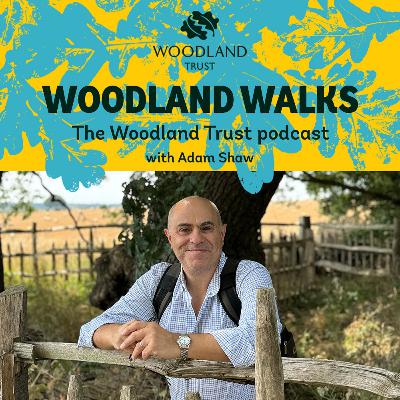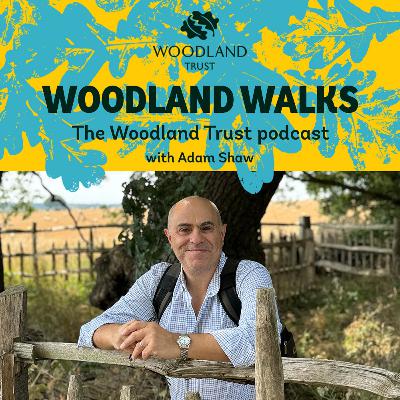4. Magnificent oaks: wildlife, folklore and competition contestants
Description
Did you know oak supports over 2,300 species of wildlife? Discover this and more fascinating facts in our episode dedicated to the nation's favourite tree. We join Trust experts, Jules and Kate, at Londonthorpe Woods, near Grantham, to find some fascinating growths on oak trees, known as galls, and learn why hunks of deadwood are so important.
We then visit the star of the show and 'Lincolnshire's best kept secret' - the astonishing 1,000-year-old Bowthorpe Oak. It's one of 12 amazing oaks in the running for 2024 Tree of the Year. Which one will you vote for?
Don't forget to rate us and subscribe! Learn more about the Woodland Trust at woodlandtrust.org.uk
Transcript
You are listening to Woodland Walks, a podcast for the Woodland Trust presented by Adam Shaw. We protect and plant trees for people to enjoy, to fight climate change and to help wildlife thrive.
Adam: Well, in this podcast, we're looking at the Woodland Trust's Tree of the Year competition, which is all about oaks and is on a quest to find the nation's favourite one. And there are lots to choose from. There is the Elephant Oak in the New Forest, the Queen Elizabeth Oak in West Sussex, the Darwin Oak in Shropshire, the Capon Oak on the Scottish Borders and plenty of others to choose from across Wales, Somerset, County Fermanagh, Cheshire and well, lots of other places as well. And you can vote for your favourite oak by going to the shortlist of them at the voting site woodlandtrust.org.uk/vote, so that is woodlandtrust.org.uk/vote and we'll repeat that again at the end of this podcast.
Well, today I'm going to see one of the oaks in contention for the Tree of the Year, the Bowthorpe Oak in Bourne, in Lincolnshire, a tree which has a hollow interior and had previously, that interior had been fitted with seats and had been used as a dining room for 20 people in the past, 20 people! It must have been an enormous oak and that's not a practice I think that's recommended these days. Well, certainly not. But nonetheless it's a great oak which has played a great big part in the local landscape and is much loved, not just in the UK but attracts plenty of visitors from abroad as well. Now, oaks have an amazingly important part in our culture and in days gone by were, I think, central in Druid folklore, for instance, in fact one amazing fact I have learnt making this podcast is that the name Druid comes from druer, the Celtic for oak for the word oak and wid means to know, so Druid means oak-knower, so there's a good fact for you. Anyway, enough of me. I'm off to meet some people who know all about oaks and unusually I am not starting by a tree. So, unusually, we're starting in a car and I'm joined by two women from the Woodland Trust. So first of all, introduce yourselves.
Kate: I'm Kate Lewthwaite. I am citizen science manager at the Woodland Trust.
Adam: Wonderful. And our driver for the day is...
Jules: Hi, I'm Jules Acton. I'm a fundraiser with the Woodland Trust.
Adam: So we're going to look at a few oaks today, one of which is actually in the running to be the Tree of the Year, and you can vote on that still and I'll give you details a little later on on how to do that. But first of all, you were telling me that you have a little present for me. I always like to start the day with a little present.
Jules: It's always good to start the day with a little present, I think and here's a little one for you.
Adam: Oh, and it's wrapped up in tissue paper. It's an early Christmas present. How very good. So what is that? OK so do you want to describe it?
Jules: OK so it's a little, it looks like a little woody marble really, doesn't it? And it's got a little tiny hole you can see just there and some extra other little tiny holes. That is an oak marble gall.
Adam: An oak marble...ghoul?
Jules: Gall.
Adam: And how do you spell that?
Jules: G A double L.
Adam: G A double L and what what is it?
Jules: So this is this is incredibly special, so this has in many ways changed human culture, this little tiny thing. Certainly amplified human culture. So this is a gall, which is made by, and it's made by a little tiny wasp. And the wasp lays a an egg in the in the bud of the tree of the oak tree. And it makes the oak change and it sort of changes chemically. It's really strange. And it makes the the oak form this little marble shaped thing on the end of a twig. And that becomes home for the gall wasps' larvae, and so that the little larva grows up inside it and it has this its own special home, but it's also full of lovely food. So that's interesting itself and that it's it's it's it's got this sort of little little home but it what's particularly interesting human, from the human perspective is that these kind of galls were used to make ink for about 1,000 years and the the kind of ink that they made, it was used, I think, until the middle of the 20th century. So kind of until quite recently. So Shakespeare's plays were written on oak gall ink, Newton's theories, the American Declaration of Independence, huge amounts of historic documents.
Adam: So just trying to understand that, Shakespeare's plays were written on ink created by this thing?
Jules: By a gall like, yeah, this kind of thing by by a gall. Yeah. But you can you can still now you can make gall gall ink from these little little things here. So it in many ways it it amplified, this little tiny thing we've got here, amplified the whole course of human history, culture, etcetera in our part of the world.
Adam: Quite an extraordinary place to start our journey today. Wonderful. So, OK, so we're, yes, we'll put that away nice and safe and we'll start our journey. Kate, do you just want to start by telling me what we're going to do when we get out of the car?
Kate: We're going to have a walk round Londonthorpe Wood, which is one of the Woodland Trust sites, one of our thousand woods that we own and we're going to see an oak tree that Jules has found for us to go and talk about.
Adam: Fantastic. All right, well, let's go.
Jules: Well, well so we've just seen some amazing galls on what looks like quite a young tree, it's probably about 30-years-old, would you say, Kate, this one?
Kate: Maybe, yes.
Jules: And, yeah, they're they're bright red and they're on the underside of the oak leaves and they look a bit like cherries and
Adam: I was going to say, the one you showed me was all grey, you gave me an old rubbish one, didn't you? This is what they look like when they're on the tree. It's red, it does look like a cherry.
Jules: Yeah, this is a particularly stunning one, isn't it? And they they are literally called cherry galls. And they again
Adam: They're called cherry balls?
Jules: Cherry galls.
Adam: Galls, cherry galls.
Jules: And they're about the same size as the marble gall that we saw earlier. And I believe they are also caused by a gall wasp. And but what is good about these kind of galls is that they're relatively easy to spot. So once you get your eye in, you start seeing them everywhere, so it's a really lovely thing to start doing, you know, with children or just looking yourself when you're out on a on a walk, you know.
Adam: Wow. So that shows that a wasp has formed that?
Jules: Yeah
Adam: And these are non-stinging wasps, aren't they?
Jules: These are non-stinging wasps. They're teeny, teeny, tiny wasps. They don't look like your your black, you know the big black and and and yellow stripey things that come at your ice cream, not that there's anything wrong with those wasps, they're lovely too.
Adam: Inside that gall is baby wasps? Is that?
Jules: There will be a little larvae inside there.
Adam: And that's what they're using as as food, or is it?
Jules: Yes, that's their home but it's also their food source. And I'm not at some point in the year the the the little tiny wasp, once it's developed, will will kind of drill its way out and then be set free to the to the wider world. But I think we'll find some other kinds of galls, actually. So it might be worth us moving on a little bit and just see if we can.
Adam: OK. Moving on, yeah, that's politely telling me to be quiet and start walking.
Jules: Oh sorry *laughs*
Adam: Sorry, there's a, oh it's a tractor going up and down the field next to us.














